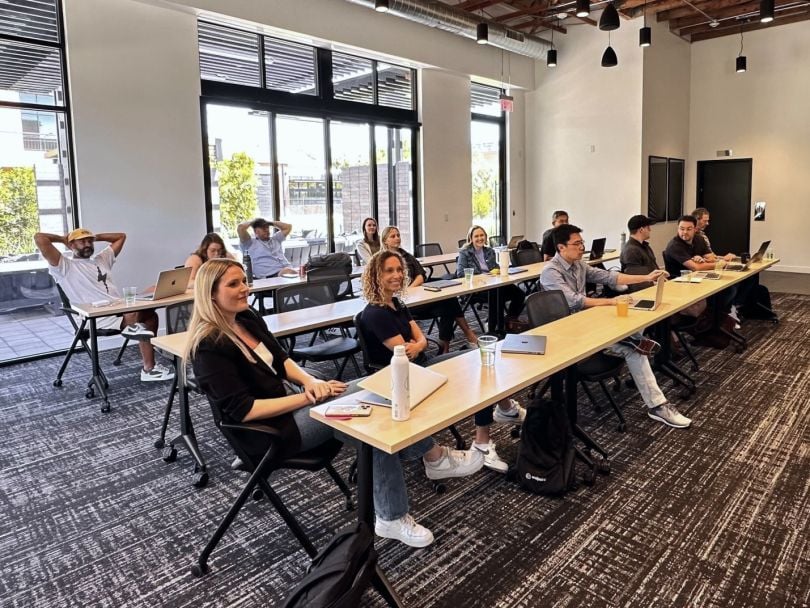On the afternoon of March 11, 2020, the world changed forever.
College students moved back home, restaurants closed and employees shifted to working remotely. Yet in the chaos, humanity showed its resilience, finding silver linings in the midst of adversity: families reunited, enjoying more homemade meals — and lest we forget, endless amounts of banana bread.
The next year, as schools reopened and dining out resumed, one trend stuck. The remote work revolution gained momentum, offering improved work-life balance and greater flexibility.
Certain tech companies have even embraced this shift permanently, though not without challenges — specifically, maintaining teamwork and fostering company culture across time zones.
To address these challenges, companies like RTB House, VelocityEHS and Starburst lean on digital collaboration tools, like Zoom and Slack, and proactive leadership to meet the evolving needs of their employees.
Recently, Built In sat down with these companies and others to discover how they achieve genuine connection through the screen.
Featured Companies
RTB House is an advertising technology company that provides marketing technologies for brands and agencies worldwide.
What is the biggest challenge to establishing a virtual-first company culture?
Resisting the urge to simply replicate the office environment online.
When we initially transitioned to a virtual-first model, we realized that attempting to mirror the physical office culture in a digital space was not effective. Through extensive employee feedback, we discovered that our team members did not desire a return to the old office culture. Instead, they preferred a culture that offered diverse engagement options. Some team members thrive on frequent celebrations and connection moments, while others appreciate having these opportunities available to opt into as they choose. To address this, we continually seek and incorporate feedback from our employees, enabling us to create a flexible and inclusive culture.
“Some team members thrive on frequent celebrations, while others appreciate having these opportunities available to opt into as they choose.”
By providing a variety of meaningful moments tailored to individual preferences, we ensure our virtual-first culture resonates with everyone, fostering a stronger, more connected team.
What’s your number one tip for fostering connection and/or collaboration among virtual teams?
To intentionally create opportunities for meaningful, non work-related interactions.
In virtual business meetings, the focus is typically on sharing information and advancing projects. While this can naturally lead to effective collaboration, it often doesn’t foster deep, personal connections. To truly build strong relationships within your team, it’s essential to set aside dedicated time for informal, social interactions. These moments can be organized by HR, internal culture committees, department leaders or even the employees themselves.
Whether it be through team socials and bonding activities or casual Slack channels, the key is to attempt to establish and share discussion topics ahead of time to ensure the interactions are engaging and inclusive. By prioritizing these intentional, non work-related activities and conversations, teams can cultivate a sense of camaraderie and trust, which ultimately enhances overall collaboration and productivity.
What remote working tools do you lean on to reinforce culture?
We rely on a combination of remote-work tools and strategic in-person gatherings.
Frequent reminders and interactions are the lifeblood of our culture. Tools like Slack, email and infographics play a pivotal role in celebrating birthdays, holidays and virtual events, and help to foster a sense of community and belonging. Our Culture Committee, which meets bimonthly and is open to all team members, is another crucial component. These meetings are dedicated to planning celebrations and virtual events, assigning responsibilities, brainstorming new ideas and ensuring diverse participation and continuous cultural enrichment.
While virtual tools are invaluable, the significance of in-person meetings cannot be overstated. We strive to have departments meet in person annually to learn, strategize and connect. Additionally, we aim to bring the entire team together once a year to align on company goals and enjoy quality time together.
VelocityEHS is a cloud-based software company that helps clients reach their environmental, health, safety and sustainability goals faster.
What is the biggest challenge to establishing a virtual-first company culture? How is VelocityEHS working to overcome that challenge?
Ensuring our perks and programs are equitable and engaging for our global workforce.
The first step was creating our remote-first work plan, “Work for All” which covers topics like communication norms, meeting etiquette and home office ergonomics to set virtual-work expectations.
Additionally, it was crucial to build communities that are not limited by location. We support over a dozen employee-led affinity and special interest groups that organize companywide initiatives and support each other through group meetings and chats.
Our global teams benefit from the “Belonging Dollars” program, where departments receive budgets for engagement activities tailored to their team culture. These activities range from virtual gaming events and guest speakers to branded swag, catering to various team dynamics.
Our Employee Experience Team continually evaluates and adjusts our programming and partnerships to keep up employee engagement regardless of physical location. We use insights from attendance, participation and employee feedback to make sure our programs work for all.
What’s your number one tip for fostering connection and/or collaboration among virtual teams?
Give employees the space to bring their whole selves to work. While remote work offers many benefits, we can’t ignore the nuances we lose by not working in person every day. Small, everyday observations can make connections and community building easier. In a virtual-first environment, we need to create opportunities for our employees to find community. Those who participate in our employee-led initiatives, like affinity and special interest groups, connect with colleagues over shared identities or passions that are integral to who they are.
“While remote work offers many benefits, we can't ignore the nuances we lose by not working in person every day. … We need to create opportunities for employees to find community.”
Employees are more engaged and productive when they can bring their whole selves to work. They feel more comfortable sharing ideas and perspectives, asking for help and being part of a team. It’s our job to provide these opportunities.
By encouraging participation in these communities, we foster real connections in our virtual culture.
What remote working tools do you lean on to reinforce culture?
We are always revisiting our tools to ensure our employees have the best possible virtual-first work experience. After four years of being virtual first, we have some favorites.
For a wide variety of live-hosted team building and culture events, we partner with Confetti. One highlight is our annual Drag Queen Bingo party to celebrate the end of Pride Month, which we look forward to every year.
For speaking engagements, we use PepTalk, a platform with a network of thousands of experts for virtual or in-person events and workshops. We’ve used PepTalk to celebrate cultural history months and support our DEIB initiatives. Most recently, Sian Sutherland, co-founder of A Plastic Planet and climate advisor, joined us for our Sustainability Committee’s Plastic-Free July event.
We strongly believe in access to mental health care and encouraging our employees to prioritize their mental well-being. Our Mind affinity group promotes and normalizes discussing mental health and neurodiversity in the workplace. Employees enjoy benefits from Modern Health, including access to virtual therapy, coaching, community circles and a digital library of well-being materials.
Starburst is a data company that provides a fast and scalable data lakehouse powered by Trino, the leading SQL analytics engine.
What is the biggest challenge to establishing a virtual-first company culture?
Fostering a fun, supportive and highly productive work environment was hard enough when things were in-person. People have different working styles, career goals, personal obligations — even different most-productive time windows. Being virtual-first just makes all those challenges 10 times harder.
We have to remember that even though our work interactions are mostly through a computer screen, there are living, breathing human beings on the other end, and their wants and needs aren’t different just because the company is virtual first.
“There are living, breathing human beings on the other end of the computer screen, and their wants and needs aren't different just because the company is virtual first.”
Starburst has been a huge supporter of virtual-first culture by providing the resources and support to help our teams form human connections, not just professional ones. We are encouraged to allocate budget for team offsite, and we coordinate in-person training and travel regularly to visit remote offices to form real relationships across time zones.
Our people team helps to sponsor employee-organized virtual events on a regular basis.
What’s your number one tip for fostering connection and/or collaboration among virtual teams?
Treat people like people and get to know them. When everything is a Zoom meeting, it’s easy to just jump from one topic to another, which is something you would never do if the same meetings were held in person. In person, there would always be a few minutes between meetings to ask how someone’s family is doing or talk about how bad the coffee is that day.
Making time for personal conversations during scheduled meeting times is a good way to foster trust and relatability, which is vital for collaboration. On Mondays, I run my full team meeting and dedicate at least five minutes to talking about what people did during the weekend. Some may find it a waste of time, but it acts as a forcing function for the team to learn a little bit about each other every week.
In addition, I like to schedule multiple touch points for my team throughout the week. We do cover important updates throughout the week, but more importantly, it gives me an opportunity to ask how they're doing personally and if I, or anyone else on the call, can help in any way.
What remote working tools do you lean on to reinforce culture?
In a remote environment, we have to give employees the tools, information and empowerment to figure stuff out asynchronously.
We communicate largely through Zoom and Slack and collaborate via a shared document on which team members can write their weekly updates. This gives them an opportunity to see what each person is working on, review documents and share comments, while fostering transparency, accountability and collaboration.

HealthJoy is a healthcare guidance and engagement platform that helps employees make better healthcare decisions.
What is the biggest challenge to establishing a virtual-first company culture? How is HealthJoy working to overcome that challenge?
Fostering relationships outside of your day-to-day contacts. The implementation team at HealthJoy makes it a priority to get to know each other outside of a work context. One example is how we end our team meetings with a question of the week, such as, “Bring out your inner influencer and recommend something to the team.”
We’ve also hosted team brunches that included superlatives voted on by the team, team trivia events — even surprise baby and wedding showers for team members, all held remotely.
What’s your number one tip for fostering connection and/or collaboration among virtual teams?
Building connections virtually can take more time and effort but is incredibly worth it. Don’t be afraid to reach out and set up a chat with a team member you may not have worked with yet. Taking the time to get to know your coworkers makes collaboration easier and more seamless.
“Taking the time to get to know your coworkers makes collaboration easier and more seamless.”
What remote working tools do you lean on to reinforce culture?
Slack is very important to us as a company. We have constant communication in Slack, both for team collaboration and for fun. We have channels devoted to cooking, music, running and celebrity news. We also love sending gifs and custom memes.
In addition, all internal meetings held via Zoom are “cameras on.” We like to encourage people to be more than a box.
Envoy Global is a global immigration services company that provides software and solutions to help businesses hire and manage a global workforce.
What is the biggest challenge to establishing a virtual-first company culture?
The cornerstone of cultivating a strong company culture is fostering relationships. Developing a virtual-first company culture presents several obstacles, from integrating the diverse cultural backgrounds of employees to ensuring the availability of the necessary infrastructure and support for effective virtual interactions.
Building trust within teams is crucial to ensure that this mode of work will not compromise productivity while respecting flexibility. Additionally, managing a healthy work-life balance poses a significant challenge for many, as the clear boundaries present in an office setting are often blurred in a remote environment.
We employ various strategies to address the challenges mentioned and prioritize a transparent culture from the top down. We encourage strong working relationships through regular one-on-one meetings and video usage during virtual interactions. We also schedule non-work meetings, such as coffee clubs and other hobby groups, to build relationships. Managers are trained to be mindful of professional boundaries and to establish routines that prevent team burnout and also normalize breaks to ensure they remain focused and productive.
“We schedule non-work meetings, such as coffee clubs and other hobby groups, to build relationships.”
What's your number one tip for fostering connection and/or collaboration among virtual teams?
Building relationships and trust is paramount when creating a virtual work environment. This is particularly crucial as the absence of physical contact can make employees more susceptible to negative thoughts.
Excellence in communication can be achieved by creating multiple channels that encourage open dialogue, foster active participation, enhance relationships and cultivate a sense of belonging and shared purpose.
Better collaboration can be attained through system transparency, along with well-designed and developed tools focused on employee development and well-being. This includes offering virtual training, establishing mentoring programs and creating continuous learning opportunities.
What remote working tools do you lean on to reinforce culture?
Building remote culture requires a high level of adaptability, creativity and a willingness to adapt to technology. Companies can leverage the latest technology to build a robust, cohesive and productive culture.
Apart from communication tools like Slack and Teams, companies can explore other digital tools for interacting and celebrating achievements. Virtual team building activities, recognition programs and social events build cohesiveness and increase belonging among employees. Encouraging them to share their personal interests and achievements can also build a sense of community and enhance collaboration.
Company intranet can also be a one-stop shop. Employee self-service tools can reduce dependency on administration staff for various routine activities, while increasing their sense of independence.
TrueML is a fintech company that builds software to create positive experiences for consumers seeking financial health.
What is the biggest challenge to establishing a virtual-first company culture?
Maintaining a sense of connection and community among employees who are physically dispersed and culturally diverse.
To tackle this, we prioritize virtual social events like coffee chats, team-building activities and “Let’s Talk” sessions to mimic spontaneous office interactions. Second, we ensure clear and consistent communication through tools like Slack, Google Meet, Canva, Monday.com and Jira to keep everyone aligned. Regular check-ins and virtual office hours help team members feel supported.
Lastly, we are building a strong, inclusive culture by celebrating our diverse backgrounds and achievements, particularly with our recent expansion into Latin America. This includes recognizing personal milestones, encouraging peer recognition and promoting belonging through diversity and inclusion initiatives spearheaded by our Employee Experience Committee. By investing in these areas, we're not just overcoming the challenge of a virtual-first environment; we're aiming to thrive, fostering a cohesive, motivated and engaged workforce.
What’s your number one tip for fostering connection and/or collaboration among virtual teams?
Be intentional and stay thoughtful. In a virtual environment, spontaneous interactions are rare, so it’s crucial to make a conscious effort to connect. Encourage open dialogue and actively seek input from team members to make them feel valued and heard.
Additionally, be mindful of different time zones and cultural backgrounds, ensuring that meetings and communications are inclusive and considerate of everyone’s schedules and preferences.
Promote a culture of transparency and trust by being open about goals, challenges and successes. Your people are your best source of inspiration for creating out-of-the-box ways to connect and interact. Truly be curious and enthusiastic to try events or activities that various teams believe might be fun ways to connect.
Lastly, recognize that sometimes your virtual scavenger hunt might flop — and that’s OK. You joined your company because of its unique culture, so remember that whatever idea you dream up may not be a one-size-fits-all activity. Figuring out what works best for your company is part of the fun.
Remote Tools Veach Leans On
Veach uses the following tools to reinforce culture, collaboration and learning and development:
- Wellness Coach provides free access to content for employees to bring their happiest, healthiest selves to work, offering on-demand sessions and private coaching in an array of areas.
- Nectar rewards employees with real dollars. Each month, employees receive 50 Nectar “Give Points” to award colleagues for outstanding efforts — or for just making them laugh — that can later be redeemed.
- LunaPark provides a platform for team-building games for employees to engage in instead of traditional 1-on-1s.

Endpoint is a digital title and settlement company that makes home closing easy for all.
What is the biggest challenge to establishing a virtual-first company culture?
There are a few, one of the biggest being engaging employees. When we’re in an office, conversations, picking each other’s brains, social interactions and spontaneous meetings all happen naturally, without needing to schedule them. When we work remotely, we often lose that engagement.
Another is building connections. New connections, especially, we find more difficult to build virtually. For our new hires or individuals new to teams, it becomes more difficult to build relationships with coworkers.
And finally, inclusivity. When you’re in an office, it’s easy to include everyone because, often, they’re right next to you. When remote, our employees have more flexibility in their days, which also means we need to make a concerted effort to ensure everyone is able to join events, meetings and social gatherings. That means paying extra attention to who might be on vacation, in a different timezone and have commitments outside work.
How is Endpoint working to overcome that challenge?
Getting together in person to connect with team members live and build relationships with the person on the other side of Slack has a big impact not just on morale but also on building understanding and empathy for improved collaboration.
Transparency is also important and becomes crucial when working remotely. We host company all-hands meetings every other week to share important updates, celebrate wins, address concerns and ensure our employees get face time with our leaders.
Our people management tool, 15Five, was chosen to ensure that we gather accurate engagement data and have a designated place for our managers and employees to connect and keep track of conversations. We ask our employees to complete three annual engagement surveys and weekly check-ins to reflect on how they are feeling about their work. This enables managers to proactively manage performance, provide feedback and gather insights on how their employees are doing.
Company information should be easy to access, navigate and understand. This is the first step to transparency. We ensure that our intranet site has all these components and make it easy for employees to find our strategy, OKRs and monthly happenings. We also think it’s important to have tools that make it easy for employees to collaborate and drive alignment.
We elevate our employee experience by creating connections and highlighting various employee interests. We build and execute events that create space for collaborating outside of work so employees can get to know one another more intimately.
What’s your number one tip for fostering connection and/or collaboration among virtual teams?
Establish a company effort to connect and make connecting easy. Implement tools, have leaders emphasize and model the behavior, set the expectations and ask employees for their feedback. Whether it be virtual, in person, as a company or in teams, we see happier employees, more innovation and better business outcomes when we get together.
Remote Tools Costello Leans On
- Slack
- Notion
- Zoom
- Snappy Gifts
- Hey Taco
- Kahoot
LogicGate is a global leader in transformative risk management and compliance solutions.
What is the biggest challenge to establishing a virtual-first company culture? How is LogicGate working to overcome that challenge?
When establishing a virtual-first environment, not only can it be quite challenging to maintain employee engagement and enable collaboration, but also to track how these things are going and identify what we should continue to invest in.
As LogicGate evolved into a virtual-first culture, we’ve continued to prioritize two-way communication by continuing our monthly all-hands meetings, regular time with company leadership and leveraging the feedback collected in our annual pulse surveys to identify ways we can better support our employees throughout this evolution.
Another critical priority is investing in our leaders. So much of the day-to-day experience and engagement of employees, in-person or virtual, is based on their interaction and relationship with their manager. This becomes even more critical in a virtual environment.
We’ve also been intentional about grounding all ways of working and people programs in our core values, providing a great foundation for our teams to build upon.
What’s your number one tip for fostering connection and/or collaboration among virtual teams?
Offering a variety of ways for your teams to connect and collaborate is crucial in finding what will be most effective within your organization. It’s important to understand there isn’t a one-size-fits-all solution and that what works for a certain period may evolve over time as the needs of your employees and the business change. Similarly, different approaches make work better for different team members. It is critical to find ways to connect and listen on a regular basis.
“There isn’t a one-size-fits-all solution. What works for a certain period may evolve over time as the needs of your employees and the business change.”
By emphasizing variety in how individuals communicate, collaborate and engage with each other, over time, you create a dynamic virtual environment that strengthens relationships and enhances overall team engagement.
What remote working tools do you lean on to reinforce culture?
Slack enables employees at all levels to communicate across the company and connects them with others who share common interests through a variety of special-interest channels.
Donut has also proved to be incredibly valuable throughout the company, within different teams and as part of our onboarding and mentorship programs. Through a variety of features like randomized coffee chats, water-cooler topics and a celebrations channel, we’ve been able to enable our employees to connect with others across the organization and build meaningful relationships.
Eventus provides strategy, consulting and leading-edge technologies to make the most of every customer touchpoint.
What is the biggest challenge to establishing a virtual-first company culture? Physical location is not as important as we once thought. Employees have the same performance expectations whether they are sitting in a cubicle in the office or at home. Employers must empower their employees to be productive by establishing and communicating expectations. Communication is and will always be the most critical component of an employer-employee relationship. Adding the variable of being virtual forces employers to get back to basics with setting general office protocol — accepting or declining meeting invitations, having a representative attend meetings, establishing core working hours for client availability and more.
After communicating the basic office guidelines, employers can give employees the freedom and autonomy to do their job. As long as clients are happy, deadlines are being met and coworkers are working as a team, how, when and where the work is getting done isn’t a concern.
“As long as clients are happy, deadlines are being met and coworkers are working as a team, how, when and where the work is getting done isn’t a concern.”
What’s your number one tip for fostering connection and/or collaboration among virtual teams?
Keep it simple. Employers and managers can feel pressure to do a big, fun team-building event. These are well received but can be costly, and therefore occur infrequently.
Because employees want to interact and get to know their coworkers, Eventus coordinates virtual events where we spotlight employees’ lives and activities. Two examples are our “Proud Papa” event, for which we virtually spotlighted new dads and their little ones, and a pet event with small breakout rooms for employees to socialize with other employees and their pets.
What remote working tools do you lean on to reinforce culture?
We use Microsoft Teams and Slack and have utilized breakout rooms, polls and quizzes. Teams is an easy and fast way to encourage interaction and collaboration among employees. We have also used Kahoot! and online games to keep the interactions fun and entertaining.
Lob is a direct-mail automation company that offers personalized, scalable mail for businesses.
What is the biggest challenge to establishing a virtual-first company culture?
Maintaining team connectivity and cohesion across time zones. While valuable, digital interactions can lack the spontaneity of face-to-face connections, affecting how quickly we collaborate and bond as a team.
We tackle these challenges with solutions aimed at boosting productivity and fostering collaboration while meeting the diverse needs of our workforce. We offer coworking spaces through Deskpass and a home-office stipend to ensure everyone has a workspace that suits their needs. Our Notion hub centralizes distributed work resources and holds our community agreements, which outline our commitments and expectations, helping us to balance work and personal lives while staying responsive and accountable.
“We offer coworking spaces through Deskpass and a home-office stipend to ensure everyone has a workspace that suits their needs.”
We also champion asynchronous work and launched an asynchronous work training to promote flexibility and enable productivity and collaboration. Plus, Lob offers a stipend for local, in-person gatherings to encourage genuine connections, supported by regional community ambassadors who organize local events.
What’s your number one tip for fostering connection and/or collaboration among virtual teams?
Make it a core part of your organization’s culture and a key responsibility for managers.
Community building requires active participation, and managers set the tone. Find ways to bond on a genuine level — keep cameras on during meetings, get to know team members as individuals, ask about their personal lives and hobbies and dedicate team time to connecting beyond work obligations.
Community and connection needs to be a top priority in a virtual environment. A strong sense of community boosts trust, making it easier to share feedback and collaborate naturally. Problems get solved more effectively, and the team is engaged, driven by a collective motivation to succeed. When employees trust and support each other, you get a cohesive and productive team that is invested in each other’s success and will go the extra mile to achieve shared goals. You create an environment where employees enjoy working together, where they can show up as their authentic, best selves every day, and that is an environment where employees want to be for the long haul.
What remote working tools do you lean on to reinforce culture?
We use Notion to house all our resources, making it easy for employees to self-source information and enhance productivity. We also use Slack very heavily.
























